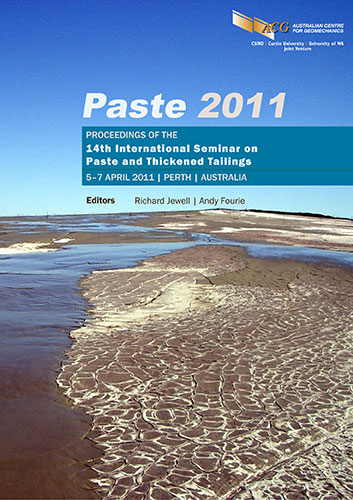Paste dewatering with the Boozer disc filter

|
Authors: Hahn, J; Bott, R; Langeloh, T |
DOI https://doi.org/10.36487/ACG_rep/1104_05_Hahn
Cite As:
Hahn, J, Bott, R & Langeloh, T 2011, 'Paste dewatering with the Boozer disc filter', in R Jewell & AB Fourie (eds), Paste 2011: Proceedings of the 14th International Seminar on Paste and Thickened Tailings, Australian Centre for Geomechanics, Perth, pp. 45-55, https://doi.org/10.36487/ACG_rep/1104_05_Hahn
Abstract:
The Boozer disc filter represents the new generation of disc filters, which defines the latest standard in the alumina industry and in the dewatering of coal slurries. Now this new type of disc filter moves into applications of paste dewatering. In a current modernisation and upgrading project of a gold and copper mine the Boozer disc filter is the chosen technology for dewatering of the gold/copper tailings to make them available for mine backfill. For this application two Boozer L4 disc filters are operated with 4 discs and 176 m² filter area each. As typical performance rate in this application the Boozer disc filters produce some 500 kg/m²h of solids throughput with a moisture content of 20 wt%. As a special highlight both Boozer disc filters are equipped with a double dewatering zone which can be activated or deactivated online. Thus, the Boozer provides for reliable operation with constant throughput, constant moisture content and complete discharge of the filter cake even with significant fluctuation of the feed flow properties. The innovative design of the Boozer provides for high throughput and dewatering performance, excellent operational reliability over a broad range of feed conditions, ease of maintenance and high profitability. Compared to filter presses, belt filters or 1970s vintage disc filters the Boozer disc filter is the most economical dewatering technology due to its high capacity, simple design and small footprint.
References:
Bott, R., Langeloh, T. and Hahn, J. (2004) Latest state of the art in Al-hydrate filtration, in Proceedings 15th International Symposium of ICSOBA – Aluminium Industry within World Economy: Problems and Trends of Development, St. Petersburg, Russia, June 15–18 2004, pp. 177–184.
© Copyright 2025, Australian Centre for Geomechanics (ACG), The University of Western Australia. All rights reserved.
View copyright/legal information
Please direct any queries or error reports to repository-acg@uwa.edu.au
View copyright/legal information
Please direct any queries or error reports to repository-acg@uwa.edu.au